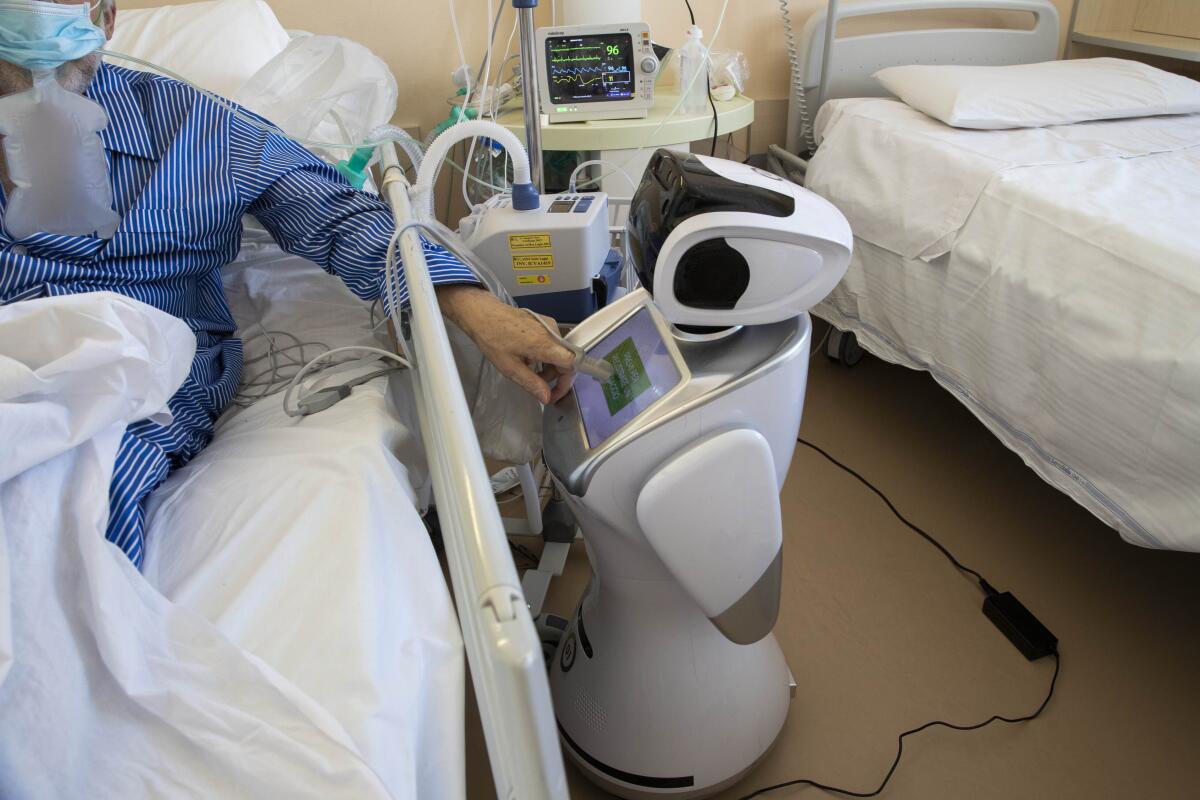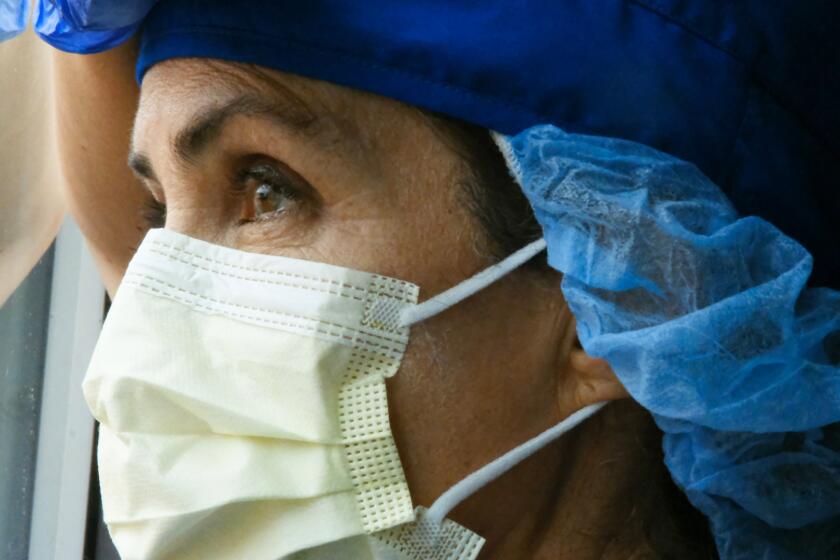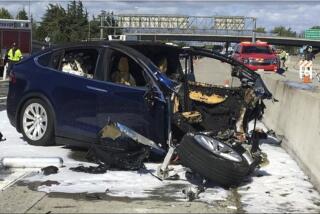Meet humanity’s new ally in the coronavirus fight: Robots
They disinfect hospital corridors with ultraviolet light to eliminate traces of the novel coronavirus. They help nurses manage routine tasks so they can spend more time with sick patients. They deliver meals to people heeding public health orders to stay at home and help police deliver warnings to those who aren’t.
As medical researchers rush to develop treatments and vaccines to deploy against the coronavirus, scientists and engineers are working on another type of weapon that could play an instrumental role in fighting the COVID-19 pandemic: robots.
“As epidemics escalate, the potential roles of robotics are becoming increasingly clear,” an international group of researchers wrote last month in the journal Science Robotics.
And there’s much more robots could do if engineers concentrated their efforts on the greatest needs, researchers said.
“At this time, we really need to ensure that we have a global orchestrated sustainable approach to [robotics] research,” said Guang-Zhong Yang, dean of the Institute of Medical Robotics at Shanghai Jiao Tong University.
Far from the big coastal hubs, a hospital in Albany, Ga., is struggling with one of the fiercest coronavirus outbreaks in the nation.
Here’s a closer look at how robots could play a larger role in the pandemic.
Robots on the front lines
A big concerns in any infectious disease outbreak is minimizing risk to the doctors, nurses and other healthcare workers who are in direct contact with sick patients. If those caregivers also become ill, it means less treatment for patients.
“When health workers are at risk, we are all at risk,” said Tedros Adhanom Ghebreyesus, director-general of the World Health Organization.
Robots could take healthcare workers’ place in certain circumstances, such as administering tests to see whether people have been infected with the coronavirus, Yang said. That’s crucial because people who seem to be perfectly healthy may in fact be infected and could spread the disease to others.
“Silent infection is the biggest problem,” Yang said.

It helps that robots don’t get sick, and — unless they run out of power — they don’t need to sleep.
Russell Taylor, a roboticist at Johns Hopkins University whose work led to the development of one of the first surgical robots, said medical robots could be useful in intensive care units where risk of contamination is a major worry.
For example, a health worker needing to tend to an Ebola patient might need to put on heavy personal protective equipment before entering a high-risk area, then remove and discard that equipment during the decontamination process at the end of her shift. That’s time-consuming, tiring and potentially dangerous.
Sending a remotely operated robot to interact with the patient instead could dramatically reduce that risk, Taylor said. After all, robots are immune to biological pathogens and can be efficiently disinfected with harsh chemicals. Not so for human beings.
Robots behind the scenes
But doctors and health workers don’t necessarily want to stop having contact with their patients, even with the risks involved, said Bill Smart, a roboticist at Oregon State University.
“The human contact part [of the job] is really important,” he said.
Robotics is still a developing field, and patient care is complex. If robots remain in supporting rather than starring roles, Smart explained, “you’re not directly interacting with the patients where it could go really wrong if the robot breaks, and you’re also not denying the patient human contact.”
That said, robots could still help minimize the risk for these front-line medical staffers by taking on more menial tasks in order to reduce the time a nurse or doctor has to spend in a dangerous environment.
That could mean using drones to transport medicine to and within hospitals, or using robots to deliver meals. Round-the-clock disinfection by wandering robots — something akin to a Roomba on steroids — could also minimize contamination risk.
Robots in the past
During the Ebola outbreak that began in 2014, the White House Office of Science and Technology Policy and the National Science Foundation organized workshops to identify ways in which robots could make a difference.
But once the epidemic came under control, interest in (and funding for) the project dried up.
“As a species we tend to be a bit ADD,” said Robin Murphy, a roboticist at Texas A&M University.
In New York City’s overwhelmed emergency rooms, doctors are using FaceTime to tell loved ones that family members have died of COVID-19.
This feast-or-famine approach to funding means scientists, engineers and medical emergency personnel aren’t likely to have robotic tools ready for when the next pandemic hits, scientists said.
It’s akin to the problem faced by scientists who work on vaccines and treatments for emerging infectious diseases. If research into the coronaviruses responsible for the outbreaks of severe acute respiratory syndrome (SARS) and Middle East respiratory syndrome (MERS) hadn’t dried up, options for fighting COVID-19 would have been more readily available, scientists say.
Robots in the future
Robotics has come a long way since that Ebola outbreak. Computer vision has gotten better, sensing capabilities have improved, and artificial intelligence has gotten smarter. All this translates into more potential for putting robots to good use.
Today, investing in robotics development is a lot like investing in a large snowplow, Murphy said. It’s expensive and not put to use for much of the year. But when a big snowstorm hits, it proves its worth.
Perhaps one solution is to put more robots in day-to-day hospital settings and make sure they can be reconfigured for a range of possible disasters scenarios. That way they can earn their keep and get experience under the belts, until the next emergency hits.
In this scenario, engineers wouldn’t design a robot specifically for the COVID-19 pandemic, Taylor said. The trick is “to find solutions that can be broadly commercialized for the next system in ways that they’re economical to have around.”
Robots on the team
Smart partnered with Doctors Without Borders after the Ebola outbreak began to present opportunities for robots to help medical staff treat patients more effectively and save more lives.
Part of the problem with designing effective emergency medical robots, he said, is that the best time to test them is during an actual outbreak. But that’s also the worst time — particularly for doctors who are relying on familiar procedures to deal with high-risk, high-stress situations.
“It’s really hard to insert new things into those work flows because if you get it wrong, more people are going to die,” Smart said.
In his off time, medical ICU nurse Oh Young-jun sketches scenes from his job within a coronavirus isolation ward in South Korea.
That’s why it’s important to make sure medical personnel are included in the development process early on. “You can’t just design a robot and take it to a hospital and say, ‘Here, use my robot,’” he said.
Making robots a more widespread part of medical care would not only help them become more economically viable, it would make them more familiar to the health workers who’ll need them in a pandemic.
“You want to integrate it into a person’s life before it becomes a stressful situation,” Smart said.








